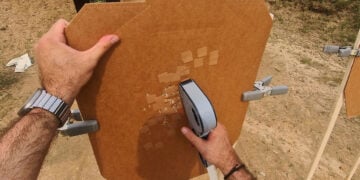
I had a friend who carries a Glock 23 every single day. He’s been doing so for at least as long as I’ve known him. One day we were at the range and I disassembled my pistol for a quick cleaning. On the bench beside me, he began to do the same. I was shocked when I watched him take apart his Glock 23.
He racked the upper receiver back and locked it to the rear. Then he depressed the slide lock and released the upper receiver. A quick pull of the trigger and the upper receiver was off. It slid forward. I knew he cleared his pistol before he did a break down of it but it was clear he had never stopped to read the owner’s manual.
So, I asked him if he knew the proper way of taking apart his Glock. I may as well have asked him if he knew how to drive his truck or if he was sure his children were really his. He begrudgingly handed it over. First, I checked to ensure it was clear — it was — and then I showed him the proper way of disassembling the Glock 23.
- Once I confirmed the pistol was unloaded, I depressed the trigger to the rear.
- Then I lightly pulled back the upper receiver — around 3/16ths of an inch.
- Depressed the slide lock button and slid the upper receiver off.
Simple. No locking the upper receiver to the rear, none of that other jazz. Both of those steps were completely unnecessary.
How did I know how to disassemble a Glock 23? I read the owner’s manual for the Glock 23 because I’ve owned one and still have a Glock 26. And then I watched a video on YouTube by an instructor showing the proper take-down method.
If this is news to you, no harm in checking out a simple video on how to properly do it. The disassembly begins at 0:40.
My range buddy was a bit kerfluffled by seeing someone else take apart his pistol for him the correct way. But, I pointed out where he could get the same information — his owner’s manual. Glock and most other major gun manufacturers are pretty diligent in ensuring an owner’s manual includes an operator level disassembly for cleaning.
They also have where proper lubrication needs to be added.
A lot of times after the range, we’ll just take apart a gun, scrub it, apply a light layer of lubrication to where metal touches metal and call good enough.
There are actually only a few recommended lubrication points for the Glock 19/23. For other handguns, those will be included in the owner’s manual.
This is why it’s always good to read the owner’s manual for any gun you own. Whether it’s just a weekend hobby shooter or a daily carry, knowing how your pistol works will help you better diagnose problems if they occur. It will also ensure the life of your pistol is just a bit better.
Proper use, disassembly, cleaning, and lubrication of any firearm requires at least a basic knowledge of how to do it. This information is usually found in the manual that comes with your gun. If that should fail, don’t be afraid to check with your gun’s manufacturing website to download a PDF of the manual.
Afterwards, if you still have questions, check around on YouTube for a video detailing the procedure you’d like to perform. There’s usually at least a couple for most major handguns on the market.









